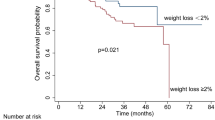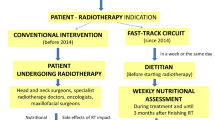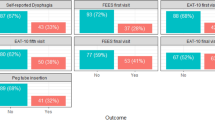Abstract
Background/Objectives:
Evidence-based practice guidelines are available to assist in the decision making for nutrition interventions in patients with head and neck cancer. Re-assessment of guideline recommendations is important with changing demographics, new treatment regimens, advancing radiotherapy techniques, such as helical intensity-modulated radiotherapy, and the emergence of new literature. The aim of this study was to validate the updated high-risk category definition in our local hospital protocol for the swallowing and nutrition management of patients with head and neck cancer to determine the ongoing predictive ability for identifying proactive gastrostomy requirement in a new cohort.
Subjects/Methods:
Patients attending a major tertiary hospital for head and neck cancer treatment from 2010 to 2011 were included (n=270). Data were collected on patient demographics (age and gender), clinical factors (tumour site, staging and treatment), nutrition outcome measures (weight, enteral feeding) and protocol adherence. Sensitivity and specificity were calculated and compared with the original validation study.
Results:
Proactive gastrostomy tubes were inserted in 86 patients. Overall protocol adherence was 93%. Sensitivity improved to 72% (increase of 18%) and specificity improved to 96% (increase of 3%) compared with the original validation study where patients received three-dimensional (3-D) conformal radiotherapy.
Conclusions:
The results of this study confirm that the updated high-risk category in the protocol for the swallowing and nutrition management of patients with head and neck cancer remains valid to predict proactive gastrostomy in a mixed population receiving helical intensity-modulated radiotherapy and 3-D conformal radiotherapy. The protocol has an improved sensitivity and specificity and hence remains just as relevant for advanced techniques of radiation treatment delivery.
This is a preview of subscription content, access via your institution
Access options
Subscribe to this journal
Receive 12 print issues and online access
$259.00 per year
only $21.58 per issue
Buy this article
- Purchase on Springer Link
- Instant access to full article PDF
Prices may be subject to local taxes which are calculated during checkout



Similar content being viewed by others
References
Nugent B, Lewis S, O'Sullivan JM . Enteral feeding methods for nutritional management in patients with head and neck cancers being treated with radiotherapy and/or chemotherapy. Cochrane Database Syst Rev 2013; 1: CD007904.
Wang J, Liu M, Liu C, Ye Y, Huang G . Percutaneous endoscopic gastrostomy versus nasogastric tube feeding for patients with head and neck cancer: a systematic review. J Radiat Res 2014; 55: 559–567.
Langius JA, Zandbergen MC, Eerenstein SE, van Tulder MW, Leemans CR, Kramer MH et al. Effect of nutritional interventions on nutritional status, quality of life and mortality in patients with head and neck cancer receiving (chemo)radiotherapy: a systematic review. Clin Nutr 2013; 32: 671–678.
Grant DG, Bradley PT, Pothier DD, Bailey D, Caldera S, Baldwin DL et al. Complications following gastrostomy tube insertion in patients with head and neck cancer: a prospective multi-institution study, systematic review and meta-analysis. Clin Otolaryngol 2009; 34: 103–112.
Chang JH, Gosling T, Larsen J, Powell S, Scanlon R, Chander S . Prophylactic gastrostomy tubes for patients receiving radical radiotherapy for head and neck cancers: a retrospective review. J Med Imaging Radiat Oncol 2009; 53: 494–499.
Rutter CE, Yovino S, Taylor R, Wolf J, Cullen KJ, Ord R et al. Impact of early percutaneous endoscopic gastrostomy tube placement on nutritional status and hospitalization in patients with head and neck cancer receiving definitive chemoradiation therapy. Head Neck 2011; 33: 1441–1447.
Lewis SL, Brody R, Touger-Decker R, Parrott JS, Epstein J . Feeding tube use in head and neck cancer patients. Head Neck 2014; 36: 1789–1795.
Silander E, Nyman J, Bove M, Johansson L, Larsson S, Hammerlid E . Impact of prophylactic percutaneous endoscopic gastrostomy on malnutrition and quality of life in patients with head and neck cancer: a randomized study. Head Neck 2012; 34: 1–9.
Salas S, Baumstarck-Barrau K, Alfonsi M, Digue L, Bagarry D, Feham N et al. Impact of the prophylactic gastrostomy for unresectable squamous cell head and neck carcinomas treated with radio-chemotherapy on quality of life: Prospective randomized trial. Radiother Oncol 2009; 93: 503–509.
Hughes BG, Jain VK, Brown T, Spurgin AL, Hartnett G, Keller J et al. Decreased hospital stay and significant cost savings after routine use of prophylactic gastrostomy for high-risk patients with head and neck cancer receiving chemoradiotherapy at a tertiary cancer institution. Head Neck 2012; 35: 436–442.
Baschnagel AM, Yadav S, Marina O, Parzuchowski A, Lanni Jr TB, Warner JN et al. Toxicities and costs of placing prophylactic and reactive percutaneous gastrostomy tubes in patients with locally advanced head and neck cancers treated with chemoradiotherapy. Head Neck 2014; 36: 1155–1161.
Kramer S, Newcomb M, Hessler J, Siddiqui F . Prophylactic versus reactive PEG tube placement in head and neck cancer. Otolaryngolo Head Neck Surg 2014; 150: 407–412.
Sheth CH, Sharp S, Walters ER . Enteral feeding in head and neck cancer patients at a UK cancer centre. J Hum Nutr Diet 2013; 26: 421–428.
Corry J, Poon W, McPhee N, Milner AD, Cruickshank D, Porceddu SV et al. Randomized study of percutaneous endoscopic gastrostomy versus nasogastric tubes for enteral feeding in head and neck cancer patients treated with (chemo)radiation. J Med Imaging Radiat Oncol 2008; 52: 503–510.
Ward MC, Bhateja P, Nwizu T, Kmiecik J, Reddy CA, Scharpf J et al. The impact of feeding tube choice on severe late dysphagia after definitive chemoradiation for HPV-negative head and neck cancer. Head Neck 2015 doi:10.1002/hed.24157.
Prestwich RJ, Teo MT, Gilbert A, Williams G, Dyker KE, Sen M . Long-term swallow function after chemoradiotherapy for oropharyngeal cancer: the influence of a prophylactic gastrostomy or reactive nasogastric tube. Clin Oncol 2014; 26: 103–109.
Crombie JM, Ng S, Spurgin AL, Ward EC, Brown TE, Hughes BG . Swallowing outcomes and PEG dependence in head and neck cancer patients receiving definitive or adjuvant radiotherapy +/- chemotherapy with a proactive PEG: A prospective study with long term follow up. Oral Oncol 2015; 51: 622–628.
Brown TE, Spurgin AL, Ross L, Tripcony L, Keller J, Hughes BG et al. Validated swallowing and nutrition guidelines for patients with head and neck cancer: Identification of high-risk patients for proactive gastrostomy. Head Neck 2012; 35: 1385–1391.
Brown T, Ross L, Jones L, Hughes B, Banks M . Nutrition outcomes following implementation of validated swallowing and nutrition guidelines for patients with head and neck cancer. Suppor Care Cancer 2014; 22: 2381–2391.
Isenring EA, Hill J, Davidson W, Brown T, Baumgartner L, Kaegi K et al. Evidence based practice guidelines for the nutritional management of patients receiving radiation therapy. Nutr Diet 2008; 65 (Suppl 1), S1–S20.
Brown T, Crombie J, Spurgin A, Tripcony L, Keller J, Hughes B et al. Improving guideline sensitivity and specificity for the identification of proactive gastrostomy placement in patients with head and neck cancer. Head Neck 2015 doi:10.1002/hed.24184.
Capelle L, Mackenzie M, Field C, Parliament M, Ghosh S, Scrimger R . Adaptive radiotherapy using helical tomotherapy for head and neck cancer in definitive and postoperative settings: initial results. Clin Oncol 2012; 24: 208–215.
van Vulpen M, Field C, Raaijmakers CP, Parliament MB, Terhaard CH, MacKenzie MA et al. Comparing step-and-shoot IMRT with dynamic helical tomotherapy IMRT plans for head-and-neck cancer. Int J Radiat Oncol Biol Phys 2005; 62: 1535–1539.
Jemal A, Simard EP, Dorell C, Noone AM, Markowitz LE, Kohler B et al. Annual Report to the Nation on the Status of Cancer, 1975-2009, featuring the burden and trends in human papillomavirus(HPV)-associated cancers and HPV vaccination coverage levels. J Natl Cancer Inst 2013; 105: 175–201.
Benson E, Li R, Eisele D, Fakhry C . The clinical impact of HPV tumor status upon head and neck squamous cell carcinomas. Oral Oncol 2013; 50: 565–574.
Petrelli F, Sarti E, Barni S . Predictive value of human papillomavirus in oropharyngeal carcinoma treated with radiotherapy: an updated systematic review and meta-analysis of 30 trials. Head Neck 2013; 36: 750–759.
Bonilla-Velez J, Mroz EA, Hammon RJ, Rocco JW . Impact of human papillomavirus on oropharyngeal cancer biology and response to therapy: implications for treatment. Otolaryngol Clin North Am 2013; 46: 521–543.
Evans M, Newcombe R, Fiander A, Powell J, Rolles M, Thavaraj S et al. Human Papillomavirus-associated oropharyngeal cancer: an observational study of diagnosis, prevalence and prognosis in a UK population. BMC Cancer 2013; 13: 220.
Ramqvist T, Dalianis T . Oropharyngeal cancer epidemic and human papillomavirus. Emerg Infect Dis 2010; 16: 1671–1677.
Gillison ML, D'Souza G, Westra W, Sugar E, Xiao W, Begum S et al. Distinct risk factor profiles for human papillomavirus type 16–positive and human papillomavirus type 16–negative head and neck cancers. J Natl Cancer Inst 2008; 100: 407–420.
Rischin D, Corry J . Weekly cetuximab/RT vs weekly cisplatin/RT in HPV-associated oropharyngeal squamous cell carcinoma (HPVOropharynx). TROG Cancer Res 2013. Available from http://www.trog.com.au/TROG-1201-HPV.
Strom T, Trotti AM, Kish J, Rao NG, McCaffrey J, Padhya TA et al. Risk factors for percutaneous endoscopic gastrostomy tube placement during chemoradiotherapy for oropharyngeal cancer. JAMA Otolaryngo Head Neck Surg 2013; 139: 1242–1246.
Jack DR, Dawson FR, Reilly JE, Shoaib T . Guideline for prophylactic feeding tube insertion in patients undergoing resection of head and neck cancers. J Plast Reconstr Aesthet Surg 2012; 65: 610–615.
Vergeer MR, Doornaert PA, Rietveld DH, Leemans CR, Slotman BJ, Langendijk JA . Intensity-modulated radiotherapy reduces radiation-induced morbidity and improves health-related quality of life: results of a nonrandomized prospective study using a standardized follow-up program. Int J Radiat Oncol Biol Phys 2009; 74: 1–8.
Sanguineti G, Gunn GB, Parker BC, Endres EJ, Zeng J, Fiorino C . Weekly dose-volume parameters of mucosa and constrictor muscles predict the use of percutaneous endoscopic gastrostomy during exclusive intensity-modulated radiotherapy for oropharyngeal cancer. Int J Radiat Oncol Biol Phys 2011; 79: 52–59.
Romesser PB, Romanyshyn JC, Schupak KD, Setton J, Riaz N, Wolden SL et al. Percutaneous endoscopic gastrostomy in oropharyngeal cancer patients treated with intensity-modulated radiotherapy with concurrent chemotherapy. Cancer 2012; 118: 6072–6078.
Rusthoven KE, Raben D, Ballonoff A, Kane M, Song JI, Chen C . Effect of radiation techniques in treatment of oropharynx cancer. Laryngoscope 2008; 118: 635–639.
Fiorino C, Dell'Oca I, Pierelli A, Broggi S, De Martin E, Di Muzio N et al. Significant improvement in normal tissue sparing and target coverage for head and neck cancer by means of helical tomotherapy. Radiother Oncol 2006; 78: 276–282.
Sheng K, Molloy JA, Read PW . Intensity-modulated radiation therapy (IMRT) dosimetry of the head and neck: a comparison of treatment plans using linear accelerator-based IMRT and helical tomotherapy. Int J Radiat Oncol Biol Phys 2006; 65: 917–923.
Lee TF, Fang FM, Chao PJ, Su TJ, Wang LK, Leung SW . Dosimetric comparisons of helical tomotherapy and step-and-shoot intensity-modulated radiotherapy in nasopharyngeal carcinoma. Radiother Oncol 2008; 89: 89–96.
Loo H, Fairfoul J, Chakrabarti A, Dean JC, Benson RJ, Jefferies SJ et al. Tumour shrinkage and contour change during radiotherapy increase the dose to organs at risk but not the target volumes for head and neck cancer patients treated on the TomoTherapy HiArt system. Clin Oncol 2011; 23: 40–47.
Chao KS, Low DA, Perez CA, Purdy JA . Intensity-modulated radiation therapy in head and neck cancers: the Mallinckrodt experience. Int J Cancer 2000; 90: 92–103.
Chatterjee S, Mott JH, Smyth G, Dickson S, Dobrowsky W, Kelly CG . Clinical challenges in the implementation of a tomotherapy service for head and neck cancer patients in a regional UK radiotherapy centre. Br J Radiol 2011; 84: 358–366.
You SH, Kim SY, Lee CG, Keum KC, Kim JH, Lee IJ et al. Is there a clinical benefit to adaptive planning during tomotherapy in patients with head and neck cancer at risk for xerostomia? Am J Clin Oncol 2012; 35: 261–266.
Duma MN, Kampfer S, Schuster T, Winkler C, Geinitz H . Adaptive radiotherapy for soft tissue changes during helical tomotherapy for head and neck cancer. Strahlenther Onkol 2012; 188: 243–247.
Brown T, Banks M, Hughes BG, Lin C, Kenny LM, Bauer JD . New radiotherapy techniques do not reduce the need for nutrition intervention in patients with head and neck cancer. Eur J Clin Nutr 2015; 69: 1119–1124.
van den Berg MG, Rasmussen-Conrad EL, van Nispen L, van Binsbergen JJ, Merkx MA . A prospective study on malnutrition and quality of life in patients with head and neck cancer. Oral Oncol 2008; 44: 830–837.
Langius JA, van Dijk AM, Doornaert P, Kruizenga HM, Langendijk JA, Leemans CR et al. More than 10% weight loss in head and neck cancer patients during radiotherapy is independently associated with deterioration in quality of life. Nutr Cancer 2013; 65: 76–83.
Capuano G, Grosso A, Gentile PC, Battista M, Bianciardi F, Di Palma A et al. Influence of weight loss on outcomes in patients with head and neck cancer undergoing concomitant chemoradiotherapy. Head Neck 2008; 30: 503–508.
de Arruda FF, Puri DR, Zhung J, Narayana A, Wolden S, Hunt M et al. Intensity-modulated radiation therapy for the treatment of oropharyngeal carcinoma: the Memorial Sloan-Kettering Cancer Center experience. Int J Radiat Oncol Biol Phys 2006; 64: 363–373.
Amin N, Reddy K, Westerly D, Raben D, DeWitt P, Chen C . Sparing the larynx and esophageal inlet expedites feeding tube removal in patients with stage III-IV oropharyngeal squamous cell carcinoma treated with intensity-modulated radiotherapy. Laryngoscope 2012; 122: 2736–2742.
Arends J, Bodoky G, Bozzetti F, Fearon K, Muscaritoli M, Selga G et al. ESPEN Guidelines on Enteral Nutrition: Non-surgical oncology. Clin Nutr 2006; 25: 245–259.
Acknowledgements
We thank Dr Tuan Ha, Radiation Oncology, for his assistance in data collection, Dr Lynda Ross for advice on writing the manuscript, Ann-Louise Spurgin and Jane Crombie, Speech Pathology, for their involvement in the initial development of the protocol, and the support of staff in medical records and the Combined Head and Neck Clinic at the Royal Brisbane and Women’s Hospital. Funding source: Royal Brisbane and Women’s Hospital PhD Scholarship.
Author contributions
TB initiated the study concept. TB, JB, MB and BH contributed to study design. VG, TB and CL participated in the acquisition of data. VG and TB analysed the data, and VG prepared the first draft of the manuscript. All the authors participated in the interpretation of the data, critical revision of the manuscript and the final approval of the submitted version. As corresponding author TB has full access to all the data in the study and has final responsibility for the decision to submit for publication.
Author information
Authors and Affiliations
Corresponding author
Ethics declarations
Competing interests
TB received a Royal Brisbane and Women’s Hospital PhD Scholarship. The funding body was not involved in the study design, data collection, analysis and interpretation of results, writing of the report or the decision to submit the article for publication. The remaining authors declare no conflict of interest.
Additional information
Supplementary Information accompanies this paper on European Journal of Clinical Nutrition website
Supplementary information
Rights and permissions
About this article
Cite this article
Brown, T., Getliffe, V., Banks, M. et al. Validation of an updated evidence-based protocol for proactive gastrostomy tube insertion in patients with head and neck cancer. Eur J Clin Nutr 70, 574–581 (2016). https://doi.org/10.1038/ejcn.2015.230
Received:
Revised:
Accepted:
Published:
Issue Date:
DOI: https://doi.org/10.1038/ejcn.2015.230
This article is cited by
-
Malnutrition, nutrition support and dietary intervention: the role of the dietitian supporting patients with head and neck cancer
British Dental Journal (2022)
-
The changing face of head and neck cancer: are patients with human papillomavirus-positive disease at greater nutritional risk? A systematic review
Supportive Care in Cancer (2022)
-
European white paper: oropharyngeal dysphagia in head and neck cancer
European Archives of Oto-Rhino-Laryngology (2021)
-
Prevalence and factors associated with double and triple burden of malnutrition among mothers and children in Nepal: evidence from 2016 Nepal demographic and health survey
BMC Public Health (2020)
-
Randomised controlled trial of early prophylactic feeding vs standard care in patients with head and neck cancer
British Journal of Cancer (2017)



